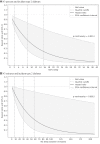Associations of Slow-Wave Sleep With Prevalent and Incident Type 2 Diabetes in the Multi-Ethnic Study of Atherosclerosis
- PMID: 37084404
- PMCID: PMC10686689
- DOI: 10.1210/clinem/dgad229
Associations of Slow-Wave Sleep With Prevalent and Incident Type 2 Diabetes in the Multi-Ethnic Study of Atherosclerosis
Abstract
Context: N3 sleep (i.e., slow-wave sleep), a marker of deep restorative sleep, is implicated in hormonal and blood pressure regulation and may impact cardiometabolic health.
Objective: We conducted cross-sectional and prospective analyses to test whether a higher proportion and longer duration of N3 sleep are associated with reduced type 2 diabetes risk.
Methods: A subsample of participants from the Multi-Ethnic Study of Atherosclerosis completed 1-night polysomnography at Exam 5 (2010-2013) and were prospectively followed until Exam 6 (2016-2018). We used modified Poisson regression to examine the cross-sectional associations of N3 proportion and duration with prevalent diabetes and Cox proportional hazards models to estimate risk of diabetes according to N3 measures.
Results: In cross-sectional analyses (n = 2026, mean age: 69 years), diabetes prevalence was 28% (n = 572). Compared with the first quartile (Q1) of the N3 proportion (<2.0%), participants in Q4 (≥15.4%) were 29% (95% CI 0.58, 0.87) less likely to have prevalent diabetes (P trend = .0016). The association attenuated after adjustment for demographics, lifestyles, and sleep-related factors (P trend = .3322). In prospective analyses of 1251 participants and 129 incident cases over 6346 person-years of follow-up, a curvilinear relationship was observed between N3 proportion and incident diabetes risk. In the fully adjusted model, the hazard ratio (95% CI) of developing diabetes vs Q1 was 0.47 (0.26, 0.87) for Q2, 0.34 (0.15, 0.77) for Q3, and 0.32 (0.10, 0.97) for Q4 (P nonlinearity = .0213). The results were similar for N3 duration.
Conclusion: Higher N3 proportion and longer N3 duration were prospectively associated with lower type 2 diabetes risk in a nonlinear fashion among older American adults.
Keywords: N3 sleep; deep sleep; diabetes mellitus; prospective studies; slow-wave sleep.
© The Author(s) 2023. Published by Oxford University Press on behalf of the Endocrine Society. All rights reserved. For permissions, please e-mail: journals.permissions@oup.com.
Conflict of interest statement
Conflict of Interest: S.R. reports consulting fees from ApniMed Inc, Eli Lilly, and Jazz Pharma and receipt of equipment for use in multicenter NIH research from Philips Respironics and Nox Medical. Other authors report no conflicts of interest.
Figures
Similar articles
-
Slow-Wave Sleep Is Associated With Incident Hypertension: The Sleep Heart Health Study.Sleep. 2018 Jan 1;41(1):zsx179. doi: 10.1093/sleep/zsx179. Sleep. 2018. PMID: 29087522 Free PMC article.
-
Association between diet quality and sleep apnea in the Multi-Ethnic Study of Atherosclerosis.Sleep. 2019 Jan 1;42(1):zsy194. doi: 10.1093/sleep/zsy194. Sleep. 2019. PMID: 30346597 Free PMC article.
-
Slow-wave sleep is associated with incident hypertension in patients with obstructive sleep apnea: a cross-sectional study.J Int Med Res. 2020 Sep;48(9):300060520954682. doi: 10.1177/0300060520954682. J Int Med Res. 2020. PMID: 32967506 Free PMC article.
-
Very short sleep duration reveals a proteomic fingerprint that is selectively associated with incident diabetes mellitus but not with incident coronary heart disease: a cohort study.BMC Med. 2024 Apr 23;22(1):173. doi: 10.1186/s12916-024-03392-1. BMC Med. 2024. PMID: 38649900 Free PMC article.
-
Cross-sectional and Prospective Associations of Actigraphy-Assessed Sleep Regularity With Metabolic Abnormalities: The Multi-Ethnic Study of Atherosclerosis.Diabetes Care. 2019 Aug;42(8):1422-1429. doi: 10.2337/dc19-0596. Epub 2019 Jun 5. Diabetes Care. 2019. PMID: 31167888 Free PMC article.
Cited by
-
Regulation of peripheral glucose levels during human sleep.Sleep. 2025 Jun 13;48(6):zsaf042. doi: 10.1093/sleep/zsaf042. Sleep. 2025. PMID: 39987458 Free PMC article.
-
Sleep Temporal Entropy as a Novel Digital Biomarker of Sleep Fragmentation for Cardiometabolic and Mortality Risk.medRxiv [Preprint]. 2025 Jun 6:2025.06.04.25328946. doi: 10.1101/2025.06.04.25328946. medRxiv. 2025. PMID: 40502576 Free PMC article. Preprint.
-
Gender-specific associations between sleep stages and cardiovascular risk factors.Sleep. 2025 Mar 11;48(3):zsae242. doi: 10.1093/sleep/zsae242. Sleep. 2025. PMID: 39425983
-
Multi-dimensional sleep health and dementia risk: a prospective study in the UK Biobank.BMC Med. 2025 Jul 7;23(1):410. doi: 10.1186/s12916-025-04251-3. BMC Med. 2025. PMID: 40624639 Free PMC article.
References
-
- Brutsaert EF. Diabetes mellitus (DM). Merck Manual. 2017. https://www.merckmanuals.com/professional/endocrine-and-metabolic-disord...
-
- Centers for Disease Control and Prevention . National Diabetes Statistics Report 2020: Estimates of Diabetes and Its Burden in the United States. Centers for Disease Control and Prevention, US Department of Health and Human Services; 2020.
-
- Yaggi HK, Araujo AB, McKinlay JB. Sleep duration as a risk factor for the development of type 2 diabetes. Diabetes Care. 2006;29(3):657‐661. - PubMed
Publication types
MeSH terms
Grants and funding
- N01 HC095163/HC/NHLBI NIH HHS/United States
- N01 HC095168/HC/NHLBI NIH HHS/United States
- N01 HC095162/HC/NHLBI NIH HHS/United States
- UL1 TR001420/TR/NCATS NIH HHS/United States
- N01 HC095159/HC/NHLBI NIH HHS/United States
- N01 HC095161/HC/NHLBI NIH HHS/United States
- K01 HL143034/HL/NHLBI NIH HHS/United States
- HHSN268201500003I/HL/NHLBI NIH HHS/United States
- N01 HC095166/HC/NHLBI NIH HHS/United States
- UL1 TR001079/TR/NCATS NIH HHS/United States
- UL1 TR000040/TR/NCATS NIH HHS/United States
- N01 HC095167/HC/NHLBI NIH HHS/United States
- N01 HC095160/HC/NHLBI NIH HHS/United States
- R01 AG070867/AG/NIA NIH HHS/United States
- N01 HC095165/HC/NHLBI NIH HHS/United States
- N01 HC095169/HC/NHLBI NIH HHS/United States
- R35 HL135818/HL/NHLBI NIH HHS/United States
- R01 HL098433/HL/NHLBI NIH HHS/United States
- R01 HL155395/HL/NHLBI NIH HHS/United States
- N01 HC095164/HC/NHLBI NIH HHS/United States
LinkOut - more resources
Full Text Sources
Medical


